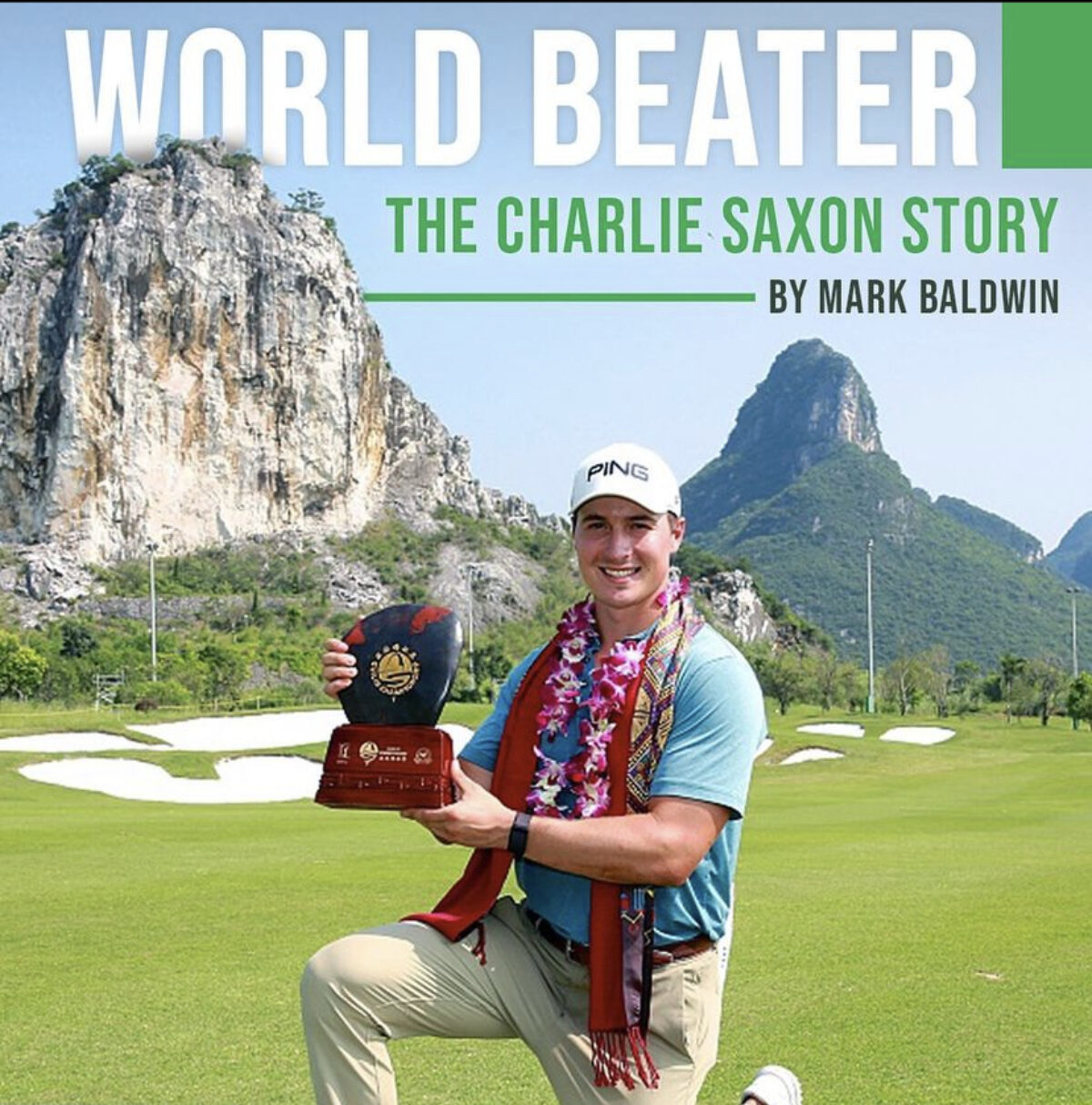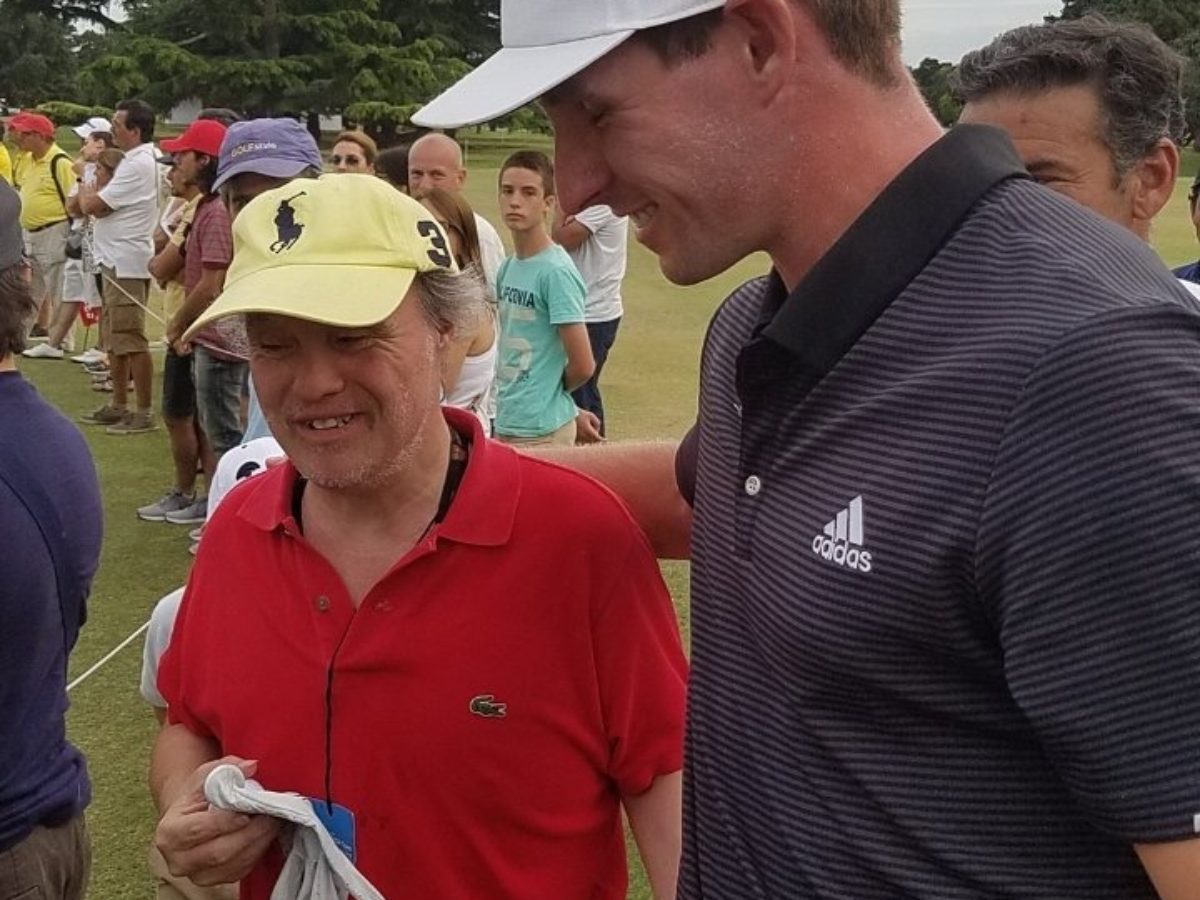World Beater–The Charlie Saxon Story
I held the solo lead after two rounds of the 2016 Henan Open in China. I didn’t know much about one of the guys who was chasing me, but then I heard the sound of the ball coming off Charlie Saxon’s driver and saw the soaring trajectory of his tee shots.
I might be in trouble today.
Riding high from a T-12 the week before at a South Korean major, the Maekyung Open, I dissected menacingly narrow St. Andrews Golf Club during the first two rounds of the opening event of the PGA Tour China season. As the wind blew in a hazy drizzle on this early Saturday afternoon, I saw Saxon’s towering driver flight. Each shot was an unwavering, tight fade. I knew it would be a different day.
I went backwards almost immediately, and Saxon took the lead within a few holes. I wish I could blame it on the weather or the golf course, but the truth was that I was intimidated.
Saxon confidently strode the fairways looking bulletproof: wide shoulders, arms that few shirts could contain, a barrel chest, and a solid base. When he stepped on the course, his boyish face with the endearing smile hardened and became intense. He would remove his glove between shots, lugging it in his mouth like a tigress carrying her cub. He seemed hungry to devour the field.
I thought I was a bomber until I faced golf’s Incredible Hulk. Saxon’s golf game took him to China and back and fueled a promising rise, which would be hindered time and again by injury.

I first met Saxon at PGA Tour China Qualifying School months earlier. After being the co-medalist, he hustled to the airport to catch a flight, crossing dozens of time zones to get to Buenos Aires for PGA Tour Latinoamerica Q school. Kunming to Beijing, Beijing to Chicago, Chicago to Dallas, Dallas to Buenos Aires. The trip took about 46 hours, and after an understandably disoriented nine-hole practice round, he played well enough to earn status.
Saxon’s professional golf career was off and running. His well-traveled mother, Jan, tagged along to visit China for the first time, perhaps in part to soften the culture shock for a kid who had grown up in Oklahoma and attended college there. Like most of us at the start of our careers, Saxon was enthusiastic, naive, and aloof, but once his name was called on the first tee, he looked unstoppable.
When he thinks back to those early days, he can only laugh. He’s 30 now, and these days, a short flight and car ride to a tournament ages him. Back then, crossing a dozen time zones between qualifiers was nothing.
“It sounded fun,” he says. “It’s like we’re living the dream playing professional golf. “If there’s an opportunity, let’s go do it and make the most of each and every opportunity.”
Saxon grew up in Tulsa with Southern Hills Country Club as his backyard. Beyond the backyard gate, his world changed. On weekends and in the summers, he would swing that gate open early in the mornings and close it late at night. He became obsessed with the game.
In 2001, the U.S. Open came to Southern Hills, and that meant the best player in the world, Tiger Woods, would be playing in Charlie’s backyard. He was 8 years old, and he and his three younger siblings excitedly held onto the ropes as Tiger stood in front of them on the 10th tee.
“Tiger hit a shot off 10 tee and Charlie yelled out after he hit in a little baby voice, good shot Tiger!” Jan recalls. “Tiger turned to him and I was like, oh my gosh, is he gonna be mad? And Tiger flashes this big toothy smile. Charlie never forgot it.”
At Oklahoma, Saxon was a teammate who could be counted on, though rarely a tournament contender. He was an early recruit of Coach Ryan Hybl, and under Hybl’s tutelage, he steadily improved each year until an injury derailed the beginning of his senior year. His career in Norman ended leaving little doubt his game needed refinement before he could even think about playing on the PGA Tour. So he chose to play the development circuits in China and Latin America.
For Saxon, chipping and pitching have always been his nemeses. The scale of his chipping challenges ranged from problematic to the full-blown yips. He wasn’t averse to putting from the high grass or hitting a flop shot when the proper play was a pitch-and-run. The chipping demons were easily hidden in China because Saxon struck his approach shots so solidly.
“The bomb-fadesman was pretty much Charlie in a nutshell,” says Callum Tarren, a PGA Tour member who was on that journey with us through China. “He hit the driver so well. It was flushery through the bag.”
That first season, Saxon built momentum through the year before a late-season charge produced his first win. He did it with a scorching 22-under-par total at Beijing’s Topwin Golf Club, former home of the European Tour’s Volvo China Open. That win bred confidence, and three events later, he won another PGA Tour China event, locking up his Korn Ferry Tour card for the following season.
“You’re in the most foreign environments as you can be with crazy travel, and you either take ownership of it and play well, or you don’t,” Saxon says. “I was able to get a lot better through competition in crazy places in the world and figure out what works for me.”

Most of us who faced Saxon that season or watched the momentum he was building assumed he was an unstoppable force. Good luck finding a competitor with anything negative to say about him. He lets his game do the talking, makes friends easily, and radiates positivity — a sponsor’s dream. We all knew his play would translate to any course in any country.
“He dominated up in China,” says Tarren. “He was always the man to beat, pretty much every week.”
What we didn’t know was that he was playing through pain.
When the season ended, Saxon realized the growing discomfort in his left hip might lead to something more serious. The diagnosis was Femoroacetabular Impingement, a common injury among longtime professional golfers, where the bones of the hip joint are so close they pinch tissue and tear the labrum. A lifetime of swinging a golf club can cause this injury. Some people are more predisposed to it than others. Saxon, only 23, had surgery at the end of 2016, before he made his debut as a Korn Ferry Tour member.
“No golfer wants to have surgery and be out and then worry, am I going to get it back?” says Jan. “Thankfully, the first hip surgery worked perfectly. He just got back on the horse and kept going.”
Thanks to an aggressive rehab plan, Saxon was swinging a club 11 weeks after surgery. He didn’t change anything in his swing, and with the hip pain gone, his swing speed returned.
Still, he didn’t make his first Korn Ferry Tour start until April. He missed nine of 15 cuts and never cracked the top 10, earning a fraction of the money he had pocketed playing in China the previous year. After six consecutive missed cuts to finish the season, he headed back to the development circuit in China.
Saxon competed on PGA Tour China and the China Tour, which awarded European Tour membership to the winner of its Order of Merit. He took the country by storm. He won four events across the two tours, topped the Order of Merit and narrowly finished second to Tarren on the PGA Tour China points list. Not only did he have status again, but he also had options.
“I was just so consistent,” Saxon says. “It didn’t matter where I was playing. I was so confident. I was shooting good number after good number. I had a five-month stretch there where it was just really consistent and pretty easy.”
Having climbed to 204th in the world rankings, Saxon was playing so well he faced a dilemma: how to navigate all the playing opportunities he had created for himself. He was now a member of both the Korn Ferry Tour and the European Tour, and the exhaustive travel was beginning to wear on him.
“The decision I made was to prioritize the Korn Ferry Tour instead of playing mostly on the European Tour,” Saxon says. “The thought was, I’m an American, my home is in the United States and my ultimate goal is to play the PGA Tour. There’s 50 cards available between the regular season and the playoffs, and with the European Tour, it’s a convoluted pathway to get back to the PGA Tour.”
Still, he felt the temptation to explore some events that offered larger purses. One week the Korn Ferry Tour stopped at Peek n’ Peak resort in the southwestern corner of New York. It’s in a remote area without much to do outside the ski and golf resort. Charlie’s caddie wouldn’t let him forget that they could have been playing for significantly more money, in a far more desirable location. The Korn Ferry event had a $700,000 purse. Saxon was also exempt that week into a tournament across the Atlantic: the Irish Open at Lahinch, whose purse was $7 million.

Importantly, his golf game was beginning to shine on the larger stage. Toward the end of the season, the Korn Ferry Tour stopped outside Salt Lake City for the Utah Championship, where the mountain air and elevation aided his already prodigious length.
With six holes left, Saxon was 4 under par in the final round and 14 under for the tournament, the score that would play off for the title. He made back-to-back bogeys on the 13th and 14th, before arriving at the 15th, a short par-5. He was 10 yards short of the green after his second shot, but with 100 feet of green between his ball and hole. The chipping demons popped into his head.
He pulled out his putter. The TV commentators were dumbfounded, and when Saxon hit the ball off the green, they were merciless. He saved par and then made a 15-foot par save on 16. When he buried another putt on 17, this time for birdie, he was back in contention.
Two nearly perfect shots at the short par-4 18th hole gave him a chance to tie the clubhouse lead. All that remained between Saxon’s ball and the hole were nine feet and a severe right-to-left slope. One of the top players on the tour that season, Harry Higgs, sat in the grandstands watching his friend attempt to secure his PGA Tour card. Higgs had finished earlier and had seen this putt a few times. Every player he watched missed the putt on the low side. He later told Saxon he was tempted to shout, “Breaks more than you think!”
The points awarded on the Korn Ferry Tour, much like the prize money, are top heavy. A second- or third-place finish is an admirable achievement, but to get to the PGA Tour, you usually have to win. This was Charlie’s chance. But Higgs was right. The putt came up short and low, as did Saxon in the season-ending points ranking.
That meant another season in the top minor league.
“Yes, I expected to get a PGA Tour card and I didn’t, so it was disappointing,” Saxon says. “But at the same time, in 2017, I played some horrific golf on the Korn Ferry Tour, and to come back in 2019 and be competitive, and really give myself a chance coming down the stretch, was validating.”
When the Tour suspended play due to the pandemic in early 2020, Saxon was living in Dallas with Scottie Scheffler and former college teammates Max McGreevy and Grant Hirschman. The four set up a gym and a hitting area in the garage, and they went to the course to play matches as frequently as restrictions allowed.
Scheffler, who was relatively new to the PGA Tour, didn’t lose much over the course of those four months, and when the Tour resumed play, Saxon bet some of his fellow players that Scheffler would be a top-five player in the world in six months. He won the bet.
Saxon’s play picked up as well. He had a handful of top 10s across the 2020-21 megaseason — a combined season due to COVID — and his best play came at the end of 2020. As the season wound down, his results became more inconsistent. Something more sinister than missed cuts nagged him: another hip injury, which led to another surgery.
Saxon went through 11 weeks of rehab before he could swing a club, and it was 16 weeks before he could compete. He chose not to take a medical leave from the Korn Ferry Tour in 2022, but when he returned to competition, his hip didn’t feel better. His mobility remained limited, he lost speed, and his swing suffered.
“It didn’t feel like the hip I had before,” Saxon says. “It’s just hard when you’re not healthy. It’s hard showing up. Golf’s hard enough as it is. You’re trying to make it to the highest level of golf against the best players in the world. Doing that healthy is difficult as it is. But doing it when you can’t quite put in the practice you want, or the hip’s nagging, it’s definitely frustrating.”
“The light kind of went out for him when he didn’t get his card back, but he’s so determined and he’s such a positive person, that he doesn’t dwell there,” says Jan. “He’s just going to work as hard as he can to get it back.”
Off the golf course, Saxon got married and moved from Dallas back to Tulsa. He and his wife, Lauren, became new parents when McArthur Paul came into the world last year. They call the little guy “Mac.” It’s a family name that goes back centuries to Scotland, a fitting connection to the home of golf. Mac’s arrival has also given the new father a new outlook.
“It’s definitely a full life-changer in a good way,” Saxon says. “It puts a whole bunch of things in perspective. Whether I play poor golf or great golf, it’s pretty frivolous now. You’ve got a little kid at home who loves me regardless of what I shoot. It’s been hard; you do something your whole life and get used to your routines, and the little guy comes in, and he’s the priority. It’s been the coolest 10 months of my life, and I wouldn’t trade it for the world.”
Saxon is home now. He knows how much work he has ahead to elevate his game. He and Lauren are learning the ropes of parenthood, and he is becoming more efficient with his time. Earlier this year, he won a two-day North Texas PGA event by four shots, a victory that was a big step in rebuilding his confidence.
He hasn’t forgotten how to win. He knows he has to continue building momentum one day at a time. He also has his sights set on Q school at the end of the year, which is awarding PGA Tour cards to the top five finishers.
“This year is pretty nuts,” Saxon says. “You can go from Joe Schmoe with absolutely no status, to the PGA Tour. There’s a lot to play for. But it doesn’t happen out of thin air. It requires putting in the work incrementally day after day.”
The Charlie Saxon I chased on a weekly basis on PGA Tour China was destined for success at the highest level of professional golf. He has experienced more highs and lows in the professional game than most players, but those early days on foreign fairways prepared him for the road ahead.
“I’ve known that when I’m playing good golf, that golf transfers at any level,” Saxon says. “I’m trying to rediscover that again. I’m trying to play Charlie golf, the golf I’ve played before, the golf that competes and has contended, and the golf that will contend again.”
Few ball flights have left an impression on me the way Saxon’s did on the driving range at the Henan Open. He’s not the same player he was back then. He has been through too much. I hope his opponents soon discover he’s more formidable because of it.





